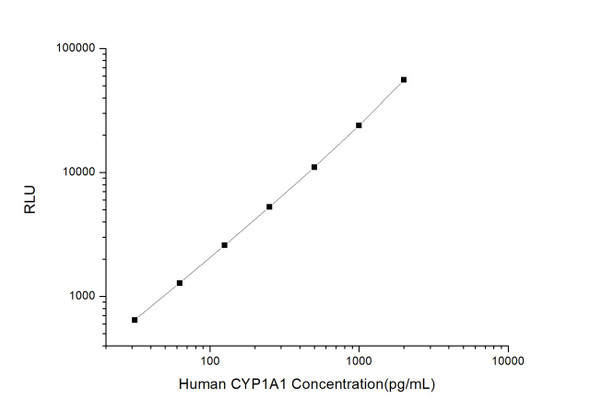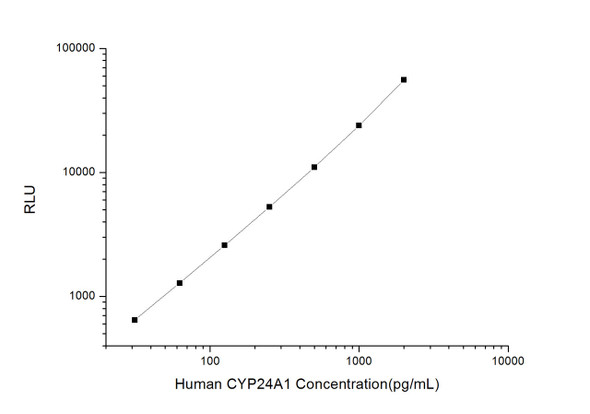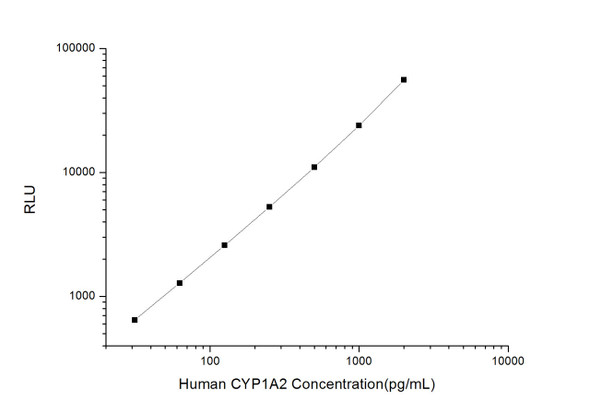Human Signal Transduction ELISA Kits
Human CYP26A1 (Cytochrome P450, family 26, subfamily A, polypeptide 1) CLIA Kit (HUES00296)
- SKU:
- HUES00296
- Product Type:
- ELISA Kit
- ELISA Type:
- CLIA Kit
- Size:
- 96 Assays
- Sensitivity:
- 18.75pg/mL
- Range:
- 31.25-2000pg/mL
- ELISA Type:
- Sandwich
- Synonyms:
- CP26, CYP26, P450RAI, P450RAI1
- Reactivity:
- Human
- Sample Type:
- Serum, plasma and other biological fluids
- Research Area:
- Signal Transduction
Description
| Assay type: | Sandwich |
| Format: | 96T |
| Assay time: | 4.5h |
| Reactivity: | Human |
| Detection method: | Chemiluminescence |
| Detection range: | 31.25-2000 pg/mL |
| Sensitivity: | 18.75 pg/mL |
| Sample volume: | 100µL |
| Sample type: | Tissue homogenates |
| Repeatability: | CV < 15% |
| Specificity: | This kit recognizes Human CYP26A1 in samples. No significant cross-reactivity or interference between Human CYP26A1 and analogues was observed. |
This kit uses Sandwich-CLIA as the method. The micro CLIA plate provided in this kit has been pre-coated with an antibody specific to Human CYP26A1. Standards or samples are added to the appropriate micro CLIA plate wells and combined with the specific antibody. Then a biotinylated detection antibody specific for Human CYP26A1 and Avidin-Horseradish Peroxidase (HRP) conjugate are added to each micro plate well successively and incubated. Free components are washed away. The substrate solution is added to each well. Only those wells that contain Human CYP26A1, biotinylated detection antibody and Avidin-HRP conjugate will appear fluorescence. The Relative light unit (RLU) value is measured spectrophotometrically by the Chemiluminescence immunoassay analyzer. The RLU value is positively associated with the concentration of Human CYP26A1. The concentration of Human CYP26A1 in the samples can be calculated by comparing the RLU of the samples to the standard curve.
| UniProt Protein Function: | CYP26A1: Plays a key role in retinoic acid metabolism. Acts on retinoids, including all-trans-retinoic acid (RA) and its stereoisomer 9-cis-RA. Capable of both 4-hydroxylation and 18- hydroxylation. Responsible for generation of several hydroxylated forms of RA, including 4-OH-RA, 4-oxo-RA and 18-OH-RA. Belongs to the cytochrome P450 family. |
| UniProt Protein Details: | Protein type:Cofactor and Vitamin Metabolism - retinol; EC 1. 14. -. -; Oxidoreductase; Endoplasmic reticulum Chromosomal Location of Human Ortholog: 10q23-q24 Cellular Component: endoplasmic reticulum membrane Molecular Function:oxygen binding; retinoic acid 4-hydroxylase activity; retinoic acid binding Biological Process: metabolic process; negative regulation of retinoic acid receptor signaling pathway; vitamin metabolic process |
| NCBI Summary: | This gene encodes a member of the cytochrome P450 superfamily of enzymes. The cytochrome P450 proteins are monooxygenases which catalyze many reactions involved in drug metabolism and synthesis of cholesterol, steroids and other lipids. This endoplasmic reticulum protein acts on retinoids, including all-trans-retinoic acid (RA), with both 4-hydroxylation and 18-hydroxylation activities. This enzyme regulates the cellular level of retinoic acid which is involved in regulation of gene expression in both embryonic and adult tissues. Two alternatively spliced transcript variants of this gene, which encode the distinct isoforms, have been reported. [provided by RefSeq, Jul 2008] |
| UniProt Code: | O43174 |
| NCBI GenInfo Identifier: | 218511987 |
| NCBI Gene ID: | 1592 |
| NCBI Accession: | O43174. 2 |
| UniProt Secondary Accession: | O43174,Q5VXH9, Q5VXI0, B3KNI4, |
| UniProt Related Accession: | O43174 |
| Molecular Weight: | 48,558 Da |
| NCBI Full Name: | Cytochrome P450 26A1 |
| NCBI Synonym Full Names: | cytochrome P450 family 26 subfamily A member 1 |
| NCBI Official Symbol: | CYP26A1 |
| NCBI Official Synonym Symbols: | CP26; CYP26; P450RAI; P450RAI1 |
| NCBI Protein Information: | cytochrome P450 26A1 |
| UniProt Protein Name: | Cytochrome P450 26A1 |
| UniProt Synonym Protein Names: | Cytochrome P450 retinoic acid-inactivating 1; Cytochrome P450RAI; hP450RAI; Retinoic acid 4-hydroxylase; Retinoic acid-metabolizing cytochrome |
| Protein Family: | Cytochrome |
| UniProt Gene Name: | CYP26A1 |
| UniProt Entry Name: | CP26A_HUMAN |
As the RLU values of the standard curve may vary according to the conditions of the actual assay performance (e. g. operator, pipetting technique, washing technique or temperature effects), the operator should establish a standard curve for each test. Typical standard curve and data is provided below for reference only.
| Concentration (pg/mL) | RLU | Average | Corrected |
| 2000 | 55514 55928 | 55721 | 55693 |
| 1000 | 22056 25892 | 23974 | 23946 |
| 500 | 11143 10921 | 11032 | 11004 |
| 250 | 5260 5328 | 5294 | 5266 |
| 125 | 2704 2512 | 2608 | 2580 |
| 62.5 | 1368 1254 | 1311 | 1283 |
| 31.25 | 633 715 | 674 | 646 |
| 0 | 27 29 | 28 | -- |
Precision
Intra-assay Precision (Precision within an assay): 3 samples with low, mid range and high level Human CYP26A1 were tested 20 times on one plate, respectively.
Inter-assay Precision (Precision between assays): 3 samples with low, mid range and high level Human CYP26A1 were tested on 3 different plates, 20 replicates in each plate.
| Intra-assay Precision | Inter-assay Precision | |||||
| Sample | 1 | 2 | 3 | 1 | 2 | 3 |
| n | 20 | 20 | 20 | 20 | 20 | 20 |
| Mean (pg/mL) | 107.07 | 266.68 | 764.75 | 115.24 | 255.66 | 802.44 |
| Standard deviation | 11.86 | 24.53 | 68.14 | 12.50 | 27.87 | 70.29 |
| C V (%) | 11.08 | 9.20 | 8.91 | 10.85 | 10.90 | 8.76 |
Recovery
The recovery of Human CYP26A1 spiked at three different levels in samples throughout the range of the assay was evaluated in various matrices.
| Sample Type | Range (%) | Average Recovery (%) |
| Serum (n=5) | 91-106 | 98 |
| EDTA plasma (n=5) | 86-96 | 91 |
| Cell culture media (n=5) | 94-108 | 102 |
Linearity
Samples were spiked with high concentrations of Human CYP26A1 and diluted with Reference Standard & Sample Diluent to produce samples with values within the range of the assay.
| Serum (n=5) | EDTA plasma (n=5) | Cell culture media (n=5) | ||
| 1:2 | Range (%) | 93-106 | 95-111 | 101-114 |
| Average (%) | 99 | 101 | 108 | |
| 1:4 | Range (%) | 100-114 | 101-113 | 85-96 |
| Average (%) | 108 | 107 | 91 | |
| 1:8 | Range (%) | 90-105 | 89-103 | 89-103 |
| Average (%) | 97 | 95 | 95 | |
| 1:16 | Range (%) | 91-104 | 91-103 | 87-101 |
| Average (%) | 97 | 96 | 94 |
An unopened kit can be stored at 4°C for 1 month. If the kit is not used within 1 month, store the items separately according to the following conditions once the kit is received.
| Item | Specifications | Storage |
| Micro CLIA Plate(Dismountable) | 8 wells ×12 strips | -20°C, 6 months |
| Reference Standard | 2 vials | |
| Concentrated Biotinylated Detection Ab (100×) | 1 vial, 120 µL | |
| Concentrated HRP Conjugate (100×) | 1 vial, 120 µL | -20°C(shading light), 6 months |
| Reference Standard & Sample Diluent | 1 vial, 20 mL | 4°C, 6 months |
| Biotinylated Detection Ab Diluent | 1 vial, 14 mL | |
| HRP Conjugate Diluent | 1 vial, 14 mL | |
| Concentrated Wash Buffer (25×) | 1 vial, 30 mL | |
| Substrate Reagent A | 1 vial, 5 mL | 4°C (shading light) |
| Substrate Reagent B | 1 vial, 5 mL | 4°C (shading light) |
| Plate Sealer | 5 pieces | |
| Product Description | 1 copy | |
| Certificate of Analysis | 1 copy |
- Set standard, test sample and control (zero) wells on the pre-coated plate and record theirpositions. It is recommended to measure each standard and sample in duplicate. Note: addall solutions to the bottom of the plate wells while avoiding contact with the well walls. Ensuresolutions do not foam when adding to the wells.
- Aliquot 100µl of standard solutions into the standard wells.
- Add 100µl of Sample / Standard dilution buffer into the control (zero) well.
- Add 100µl of properly diluted sample (serum, plasma, tissue homogenates and otherbiological fluids. ) into test sample wells.
- Cover the plate with the sealer provided in the kit and incubate for 90 min at 37°C.
- Aspirate the liquid from each well, do not wash. Immediately add 100µL of BiotinylatedDetection Ab working solution to each well. Cover the plate with a plate seal and gently mix. Incubate for 1 hour at 37°C.
- Aspirate or decant the solution from the plate and add 350µL of wash buffer to each welland incubate for 1-2 minutes at room temperature. Aspirate the solution from each well andclap the plate on absorbent filter paper to dry. Repeat this process 3 times. Note: a microplatewasher can be used in this step and other wash steps.
- Add 100µL of HRP Conjugate working solution to each well. Cover with a plate seal andincubate for 30 min at 37°C.
- Aspirate or decant the solution from each well. Repeat the wash process for five times asconducted in step 7.
- Add 100µL of Substrate mixture solution to each well. Cover with a new plate seal andincubate for no more than 5 min at 37°C. Protect the plate from light.
- Determine the RLU value of each well immediately.






